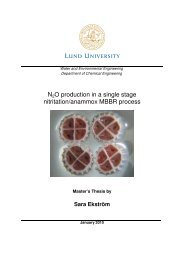Kemira Oyj/Kemira M&I ABSTRACT Vesa Kettunen ... - Svenskt Vatten
Kemira Oyj/Kemira M&I ABSTRACT Vesa Kettunen ... - Svenskt Vatten
Kemira Oyj/Kemira M&I ABSTRACT Vesa Kettunen ... - Svenskt Vatten
You also want an ePaper? Increase the reach of your titles
YUMPU automatically turns print PDFs into web optimized ePapers that Google loves.
Title: Focusing of sewer network renovations<br />
Authors: Laakso, Tuija; Vahala, Riku, Aalto University<br />
E-mail addresses: tuija.laakso@aalto.fi, riku.vahal@aalto.fi<br />
Abstract for a platform presentation to be held in English.<br />
Abstract<br />
Getting accurate and up-to-date information on the renovation need of sewer assets is difficult; on<br />
the other hand, the sewer network needs to be renovated periodically. Traditionally, in Finland, the<br />
sewer network inspections and renovations have been made based on few sources of data (e.g., pipe<br />
age and material) and not necessarily using a systematic planning approach. In such a context, the<br />
EfeSus project aims at developing a systematic, comprehensive and a partly automated procedure<br />
for deciding which assets to renovate in the network and when. The main aim of this paper is to<br />
present the project and its objectives as an example on how the improvement of sewer network can<br />
be challenged in practice.<br />
Efesus, financed largely by the Finnish Funding Agency for Technology and Innovation (Tekes),<br />
focuses on the separate sewer network of the Finnish city Espoo (population of around 250 000) and<br />
analyzes in detail 20 representative network areas. The data utilized in the assessment include:<br />
GIS data from the utility’s network information system:<br />
o pipe locations and depths, pipe diameters, slopes, materials, installation years;<br />
o closed circuit television (CCTV) inspections;<br />
o occurred operational disturbances;<br />
o water consumption in different network areas (on annual level).<br />
Flow data from the utility’s telemetry system.<br />
Rainfall data.<br />
Environmental data concerning:<br />
o ecological status of groundwater areas;<br />
o ecological status of surface water areas;<br />
o road type classifications.<br />
In order to achieve efficient prioritization of the sewer renovations these data need to be collected,<br />
evaluated and analyzed. Efesus starts by gathering and combining from different sources data that<br />
are considered useful for renovation planning. Similar to the projects CARE-S (Saegrov 2005) and<br />
COST-S (Savic et al 2005), the approach in EfeSus is includes: 1) decision-making based on<br />
available data, and 2) automated data analysis and decision support by means of a software<br />
(prototype) created in the project. The software, using as inputs all the different data collected,<br />
assesses each pipe with respect to its estimated structural and operational condition, as well as to its<br />
importance in the network structure and the vulnerability of the surrounding environment.<br />
As a result of the analysis, an index will be assigned to each pipe indicating how often the pipe<br />
should be inspected and what its renovation need is. After this, so-called renovation entities are<br />
built up from a number of pipes that can be considered similar enough to be renovated at the same<br />
time. Based on this assessment, further on-site investigations such as CCTV inspections, smoke<br />
tests and manhole inspections as well as actual renovations can be targeted and scheduled much
















